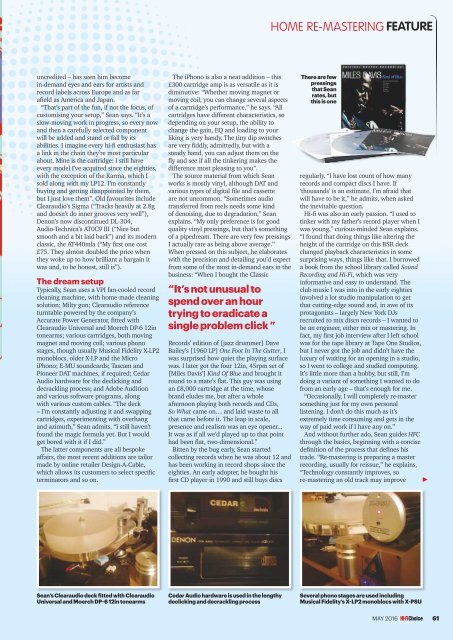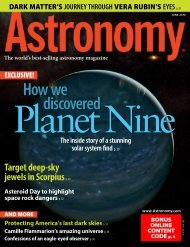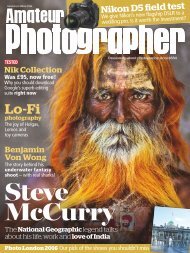Create successful ePaper yourself
Turn your PDF publications into a flip-book with our unique Google optimized e-Paper software.
HOME RE-MASTERING FEATURE<br />
uncredited – has seen him become<br />
in-demand eyes and ears for artists and<br />
record labels across Europe and as far<br />
afield as America and Japan.<br />
“That’s part of the fun, if not the focus, of<br />
customising your setup,” Sean says. “It’s a<br />
slow-moving work in progress, so every now<br />
and then a carefully selected component<br />
will be added and stand or fall by its<br />
abilities. I imagine every hi-fi enthusiast has<br />
a link in the chain they’re most particular<br />
about. Mine is the cartridge: I still have<br />
every model I’ve acquired since the eighties,<br />
with the exception of the Karma, which I<br />
sold along with my LP12. I’m constantly<br />
buying and getting disappointed by them,<br />
but I just love them”. Old favourites include<br />
Clearaudio’s Sigma (“Tracks heavily at 2.8g<br />
and doesn’t do inner grooves very well”),<br />
Denon’s now discontinued DL-304,<br />
Audio-Technica’s AT0C9 III (“Nice but<br />
smooth and a bit laid back”) and its modern<br />
classic, the AT440mla (“My first one cost<br />
£75. They almost doubled the price when<br />
they woke up to how brilliant a bargain it<br />
was and, to be honest, still is”).<br />
The dream setup<br />
Typically, Sean uses a VPI fan-cooled record<br />
cleaning machine, with home-made cleaning<br />
solution; Milty gun; Clearaudio reference<br />
turntable powered by the company’s<br />
Accurate Power Generator, fitted with<br />
Clearaudio Universal and Moerch DP-6 12in<br />
tonearms; various cartridges, both moving<br />
magnet and moving coil; various phono<br />
stages, though usually Musical <strong>Fi</strong>delity X-LP2<br />
monoblocs, older X-LP and the Micro<br />
iPhono; E-MU soundcards; Tascam and<br />
Pioneer DAT machines, if required; Cedar<br />
Audio hardware for the declicking and<br />
decrackling process; and Adobe Audition<br />
and various software programs, along<br />
with various custom cables. “The deck<br />
– I’m constantly adjusting it and swapping<br />
cartridges, experimenting with overhang<br />
and azimuth,” Sean admits. “I still haven’t<br />
found the magic formula yet. But I would<br />
get bored with it if I did.”<br />
The latter components are all bespoke<br />
affairs, the most recent additions are tailor<br />
made by online retailer Design-A-Cable,<br />
which allows its customers to select specific<br />
terminators and so on.<br />
The iPhono is also a neat addition – this<br />
£300 cartridge amp is as versatile as it is<br />
diminutive: “Whether moving magnet or<br />
moving coil, you can change several aspects<br />
of a cartridge’s performance,” he says. “All<br />
cartridges have different characteristics, so<br />
depending on your setup, the ability to<br />
change the gain, EQ and loading to your<br />
liking is very handy. The tiny dip switches<br />
are very fiddly, admittedly, but with a<br />
steady hand, you can adjust them on the<br />
fly and see if all the tinkering makes the<br />
difference most pleasing to you”.<br />
The source material from which Sean<br />
works is mostly vinyl, although DAT and<br />
various types of digital file and cassette<br />
are not uncommon. “Sometimes audio<br />
transferred from reels needs some kind<br />
of denoising, due to degradation,” Sean<br />
explains. “My only preference is for good<br />
quality vinyl pressings, but that’s something<br />
of a pipedream. There are very few pressings<br />
I actually rate as being above average.”<br />
When pressed on this subject, he elaborates<br />
with the precision and detailing you’d expect<br />
from some of the most in-demand ears in the<br />
business: “When I bought the Classic<br />
“It’s not unusual to<br />
spend over an hour<br />
trying to eradicate a<br />
single problem click ”<br />
Records’ edition of [jazz drummer] Dave<br />
Bailey’s [1960 LP] One Foot In The Gutter, I<br />
was surprised how quiet the playing surface<br />
was. I later got the four 12in, 45rpm set of<br />
[Miles Davis’] Kind Of Blue and brought it<br />
round to a mate’s flat. This guy was using<br />
an £8,000 cartridge at the time, whose<br />
brand eludes me, but after a whole<br />
afternoon playing both records and CDs,<br />
So What came on… and laid waste to all<br />
that came before it. The leap in scale,<br />
presence and realism was an eye opener...<br />
It was as if all we’d played up to that point<br />
had been flat, two-dimensional.”<br />
Bitten by the bug early, Sean started<br />
collecting records when he was about 12 and<br />
has been working in record shops since the<br />
eighties. An early adopter, he bought his<br />
first CD player in 1990 and still buys discs<br />
There are few<br />
pressings<br />
that Sean<br />
rates, but<br />
this is one<br />
regularly. “I have lost count of how many<br />
records and compact discs I have. If<br />
‘thousands’ is an estimate, I’m afraid that<br />
will have to be it,” he admits, when asked<br />
the inevitable question.<br />
<strong>Hi</strong>-fi was also an early passion. “I used to<br />
tinker with my father’s record player when I<br />
was young,” curious-minded Sean explains.<br />
“I found that doing things like altering the<br />
height of the cartridge on this BSR deck<br />
changed playback characteristics in some<br />
surprising ways, things like that. I borrowed<br />
a book from the school library called Sound<br />
Recording and <strong>Hi</strong>-<strong>Fi</strong>, which was very<br />
informative and easy to understand. The<br />
club music I was into in the early eighties<br />
involved a lot studio manipulation to get<br />
that cutting-edge sound and, in awe of its<br />
protagonists – largely New York DJs<br />
recruited to mix disco records – I wanted to<br />
be an engineer, either mix or mastering. In<br />
fact, my first job interview after I left school<br />
was for the tape library at Tape One Studios,<br />
but I never got the job and didn’t have the<br />
luxury of waiting for an opening in a studio,<br />
so I went to college and studied computing.<br />
It’s little more than a hobby, but still, I’m<br />
doing a variant of something I wanted to do<br />
from an early age – that’s enough for me.<br />
“Occasionally, I will completely re-master<br />
something just for my own personal<br />
listening. I don’t do this much as it’s<br />
extremely time consuming and gets in the<br />
way of paid work if I have any on.”<br />
And without further ado, Sean guides HFC<br />
through the basics, beginning with a concise<br />
definition of the process that defines his<br />
trade. “Re-mastering is preparing a master<br />
recording, usually for reissue,” he explains,<br />
“Technology constantly improves, so<br />
re-mastering an old track may improve<br />
Sean’s Clearaudio deck fitted with Clearaudio<br />
Universal and Moerch DP-6 12in tonearms<br />
Cedar Audio hardware is used in the lengthy<br />
declicking and decrackling process<br />
Several phono stages are used including<br />
Musical <strong>Fi</strong>delity’s X-LP2 monoblocs with X-PSU<br />
MAY 2016 61






